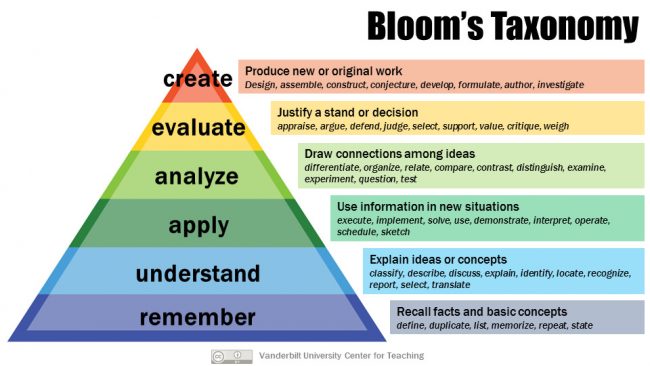Hi Pod 10!
I enjoyed reading your interactive learning resource. Critical thinking is a core competency in the BC curriculum that I strive to include in my teaching every day. According to the BC Curriculum, critical thinking is pivotal to student development because “[p]eople who think critically and reflectively are analytical and investigative, willing to question and challenge their own thoughts, ideas, and assumptions and challenge those of others. A critical thinker uses their ideas, experiences, and reflections to set goals, make judgments, and refine their thinking” (BC Curriculum, 2019).
I like how your resource has the ability to teach critical thinking while addressing all 6 of the skills from Bloom’s Taxonomy.
- Discussions use the remembering and understanding skills
- Debates use the applying, analyzing and evaluating skills
- Hands-on teaching uses the creating skill.

Below is my review of how your group met the assignment requirements. I separated my review into two sections, what I really liked, and suggestions (you may use or choose not to)
What I really liked:
- Overview of the resource
- I thought your overview of critical thinking was thorough. It is clear you researched the topic well because you have provided definitions from 2 different sources in addition to your own. I also liked how you provided misconceptions about your topic and an example of where in our real lives we need to think critically (fake news). This makes your resource real-world realistic to readers.
- Description and rationale for the learning theory (behaviourism, cognitivism, constructivism)
- I like how you modelled your resource on constructivism. I like to design learning experiences with constructivist teachings in mind. I find the most authentic learning occurs when students form their knowledge based on their own interactions and personal experiences. My pod’s learning resource is also modelled on constructivism.
- Description and rationale for the learning design you chose (inquiry, project-based, direct instruction, etc)
- I think the learning design you chose (cooperative learning) is appropriate for your topic. I agree that it is important to consider multiple perspectives and work with others to solve problems. I think no forward progress is possible without collaboration. Along with critical thinking, another core competency I teach as a part of the BC Curriculum is communication, specifically collaborating. According to the BC Curriculum “[c]ollaborating involves the skills, strategies, and dispositions that people use to work together to pursue common purposes and accomplish common goals. People who collaborate effectively recognize how combining others’ perspectives, strategies, and efforts with their own enhances collective understanding” (BC Curriculum, 2019).
- Description of your learning context (K-12, higher ed, corporate, individual, etc)
- I think the learning context works well for your chosen topic (I do think that critical thinking is possible at any age.)
- 2-4 learning outcomes (copied or revised from your blueprint)
- Your outcomes are excellent. They work really well for your discussion and debating activities. Specifically, the outcome regarding problem-solving using multiple perspectives.
- Overview of your assessment plan.
- I think your assessment plan is reasonable for your learning context. Individuals in university are assessed on a percentage scale with letter grades associated per percentage earned. As an elementary/middle school teacher I grade on a proficiency scale (emerging, developing, proficient, extending). If you are interested in learning more here is a resource explaining how we report student progress.
Suggestions:
- Brief commentary about each topic and activity/One interactive activity for each learning outcome/topic based on a resource aligned with that topic
- I like your three activities, I think they provide a logical progression of learning. My suggestion is to include some sample topics for the discussion, debate, and hands-on teaching sequence? (I.E what are they talking about, what issue are they debating)
- To take your interactive learning resource to the next level, including sample topics will make your resource classroom-ready to go if a teacher wanted to use it tomorrow.
- Overview of your plans to design for the inclusion of diverse learners
- I found the section on designing learning for colorblindness brief. I don’t think it is possible to determine a “level of colorblindness”, I know there are two types (red-green and blue-yellow) but I don’t think there is a specific level of severity. If a student is colourblind we should adapt the visual display of our materials regardless of the severity. I think the easiest way to do so is to provide all materials in greyscale.
- Also if you want to include it… Read&Write for Google Chrome is an excellent text-to-speech tool for ELL learners to gain confidence in their reading and writing skills.
- Here are some resources I found online about catering to students with colour blindness.
- https://kidshealth.org/en/parents/color-blind-factsheet.html#:~:text=Ways%20to%20help%20a%20student,labels%20in%20addition%20to%20colors
- https://www.perkinselearning.org/technology/digital-transitions/how-design-color-blindness
- https://support.microsoft.com/en-us/office/make-your-powerpoint-presentations-accessible-to-people-with-disabilities-6f7772b2-2f33-4bd2-8ca7-dae3b2b3ef25#:~:text=Select%20Start%20%3E%20Settings%20%3E%20Accessibility%20%3E,meaning%20conveyed%20by%20particular%20colors.
- Rationale for your technology choices.
- For your technology choices section, I think you should include what technology your students are using (during the discussion, debate, and hands-on teaching sequence).
- ideas: Chromebooks for research prior to discussion and debates, word processing software to write scripts for debates, presentation software for the teaching component (Canva, PPT, Google Slides?)
References
BC Ministry of Education. (2019). B.C. Curriculum – Core Competencies: Communication. Gov.bc.ca. https://curriculum.gov.bc.ca/competencies/communication
BC Ministry of Education. (2019). B.C. Curriculum – Core Competencies: Thinking. Gov.bc.ca. https://curriculum.gov.bc.ca/competencies/thinking
Recent Comments